Occupational Health and Safety Activities
Occupational Safety and Health
In order to achieve zero occupational accidents, Polyplastics has established the policies of environment safety and health at each plant, set group-wide targets, and actively works to raise safety awareness of every employee.
Group Targets
- Zero lost-time injuries and non-lost-time injuries, including at partner companies (numerical target: OIR*1≤ 0.07)
- Zero fires or explosion accidents
Main Initiatives
- Ensuring compliance with safety regualtions
- Implementing regular auditing of each plant
- Promoting activities for safety awareness raising
- Eradicating unsafe behavior and unsafe conditions through on-site patrols
- Promoting TBM&KY*2 activities
- Improving risk assessment*3 skills
- Promoting near-miss accident activities*4
- Thoroughly enforcing 5S*5 practices
- Ensuring universal adoption of pointing and calling practices
- Reducing risks from emergency situation occurrence
- *1 A safety index for the rate of occurrence of industrial accidents, based on the number of injuries, with or without lost-time, per 200,000 man-hours of labor
- *2 TBM/KY activities [Toolbox meeting (TBM) and KY (from the Japanese term for predicting danger) activities]
Prior to the start of operations, workers break into small groups and try to identify the dangers in their work operations and program for the day in order to plan safe procedures to follow. Traditionally, workers held these meetings while sitting on their toolboxes, hence the name. - *3 A series of steps to specify risks and hazards in the workplace, estimate the level of such risks, set priorities regarding operations, and decide on measures to be taken to reduce risks. Based on the results of this process, appropriate countermeasures against occupational disasters are implemented.
- *4 These activities aim to prevent accidents through the collection and disclosure of reports concerning incidents where workers narrowly avoided disasters (near-misses) during work operations.
- *5 Five basic practices for workers known as the “5S” system (based on five Japanese words beginning with “s” which translate as “sorting,” “setting in order,” “cleanliness,” “hygiene,” and “discipline,” respectively)
Group target and results
Regrettably, there were two lost-time accidents during this fiscal year and one non-lost-time accident. As a result, we were unable to reach our group target of zero accidents (including at partner companies) nor our numerical target of 0.07 OIR or lower. Urgent action was, of course, taken on-site when the accidents occurred, and more permanent mitigation and prevention measures are being investigated. We continue to pursue the serious accident prevention initiatives that we began last fiscal year and are working with partner companies to identify and address danger points.
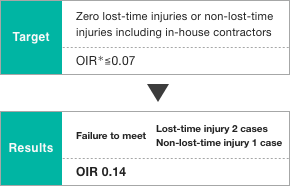
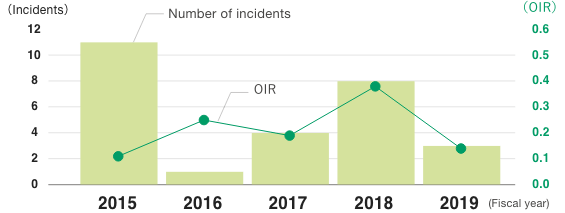
- * Occupational accident incidence safety indicator. This indicator represents the number of employee injuries (regardless of whether it resulted in lost time) per 200,000 working hours.
FY2019 Activity Topics
Fuji Plant
Working side-by-side with in-house contractors to improve on-site operational safety
At the venerable Fuji plant, which has been in operation for more than 50 years, employees are working to clean and refurbish a variety of machinery now in use but which was not envisioned when the plant was constructed. However, not a lot of information sharing about danger points took place between the Polyplastics machinery group responsible for installing and maintaining this machinery and the partner companies that are based on-site and actually use it on a daily basis. Therefore, we have been actively soliciting the perspectives and suggestions of machinery operators, including those from partner companies, as part of a system intended to identify on-site dangers, as well as examine and implement countermeasures, including construction. Since this system was begun in April 2017, a total of 71 improvement initiatives have been undertaken.
Example
This system helped us to identify that workers performing equipment repairs on the outside of the 6th floor of the plant were in danger of falling over the safety fence; as a result, the safety fence was extended to ensure workers could not fall over it.
BEFORE
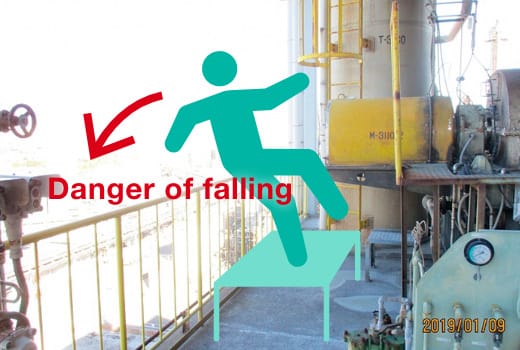
AFTER
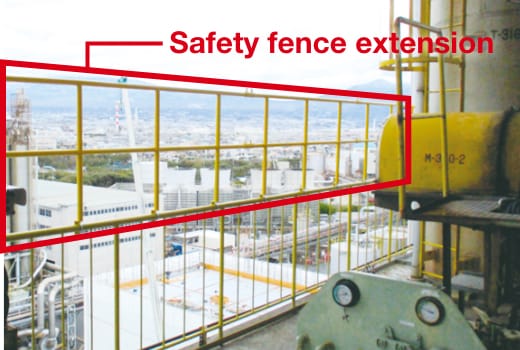
Nantong Plant
Improving safety for flammable/toxic liquid storage tanks
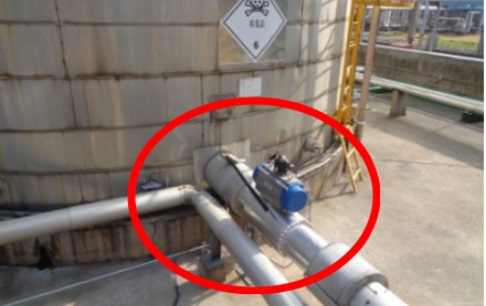
In China, the chemical plant explosion which occurred in Jiangsu Province has led to a tightening of safety and environmental protection-related regulations. In order to comply with these revised laws and regulations, and to ensure safe plant operation, our Nantong plant has added safety equipment to its storage tanks for flammable/toxic liquids in the form of automatic control devices and emergency shut-off valves. Moving forward, in addition to continued efforts to improve the safety of facilities and equipment, we plan to introduce safety equipment such as a system capable of automatically detecting the location of people inside the plant in order to prevent any exacerbation of injuries in the unlikely event of an accident.


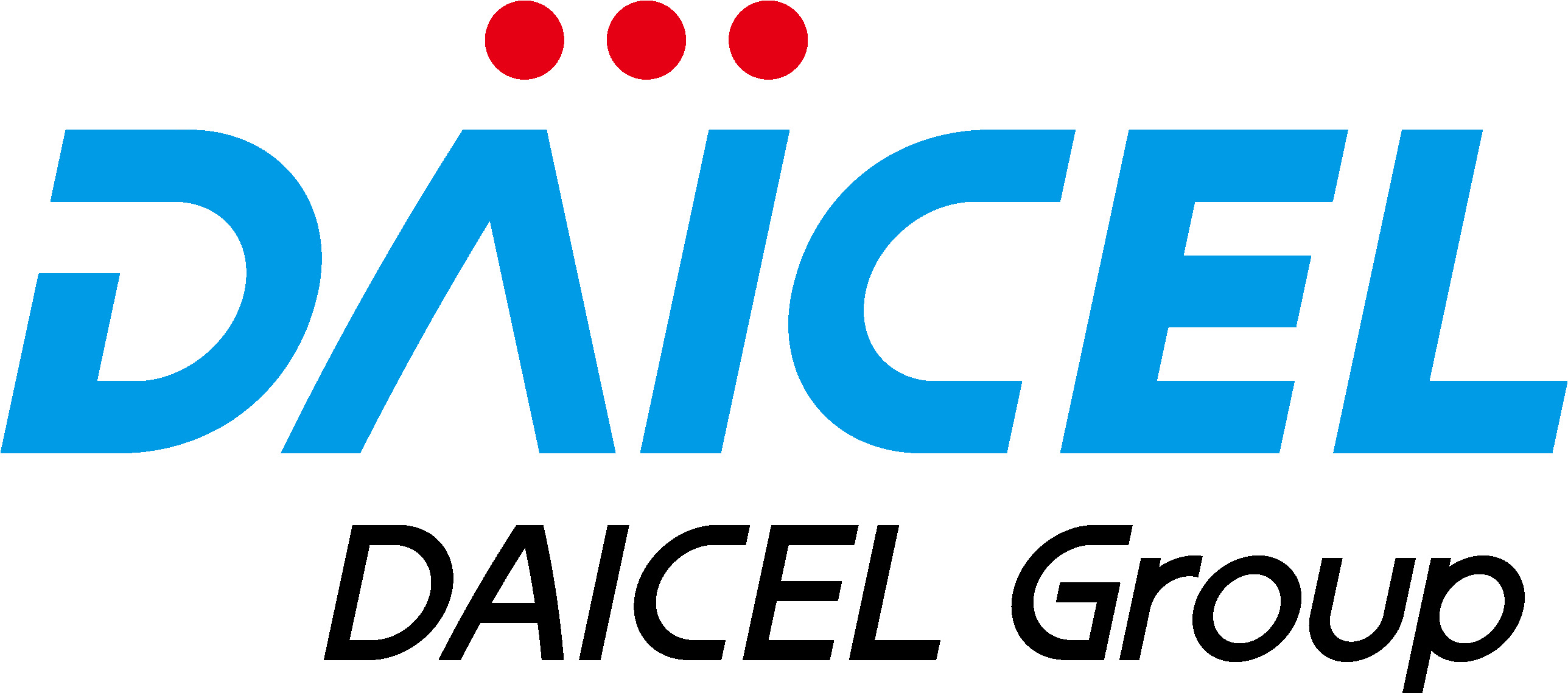






Comment from the Machinery Group
When we interviewed operators, the room of improvements was found in many operating methods and environments that we thought were acceptable.
So, we started a suggestion system to solicit improvement ideas from operators. This contributes not only to enhancing the operational safety but also to creating a better, more cooperative operating environment which is more safety-conscious.